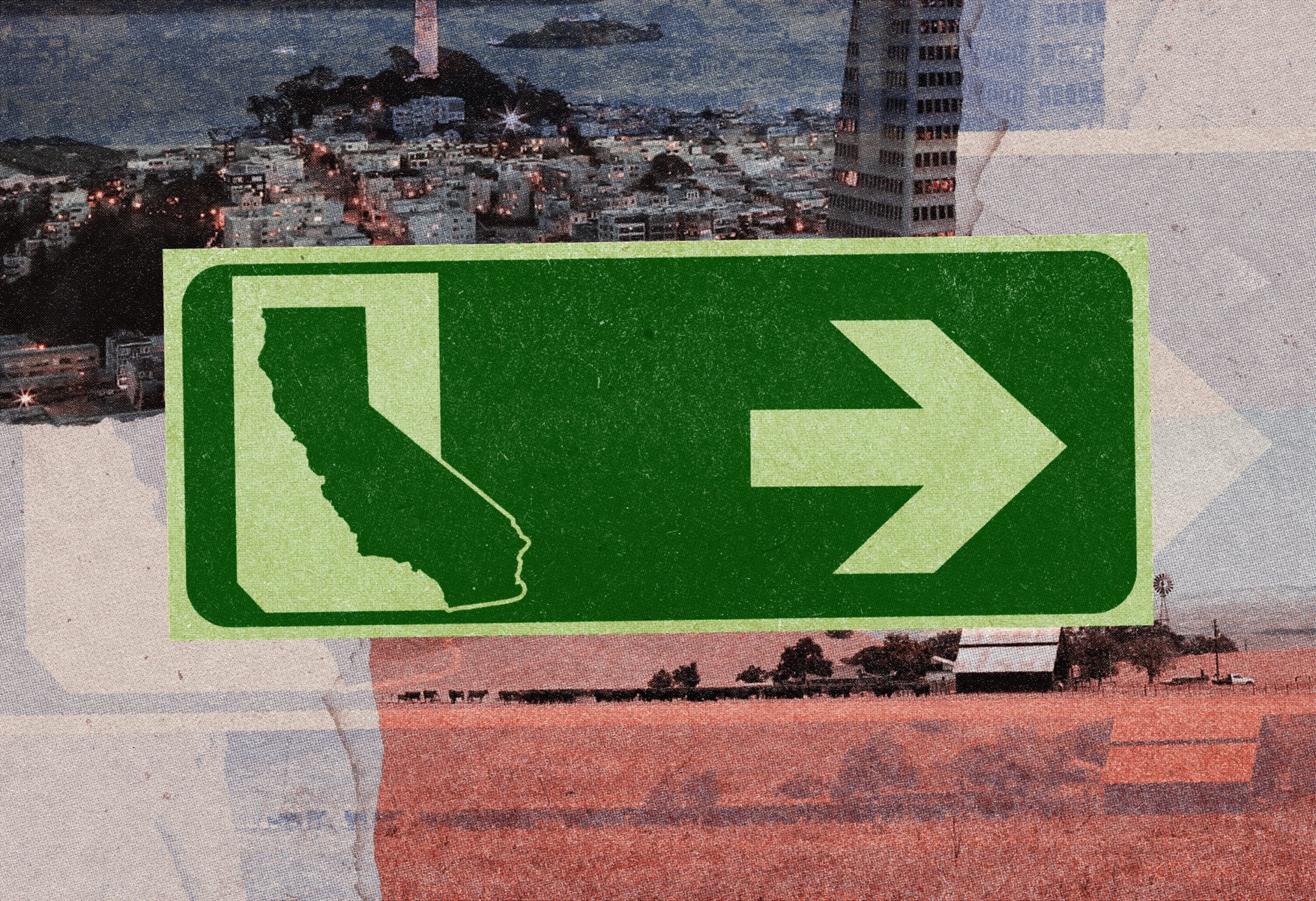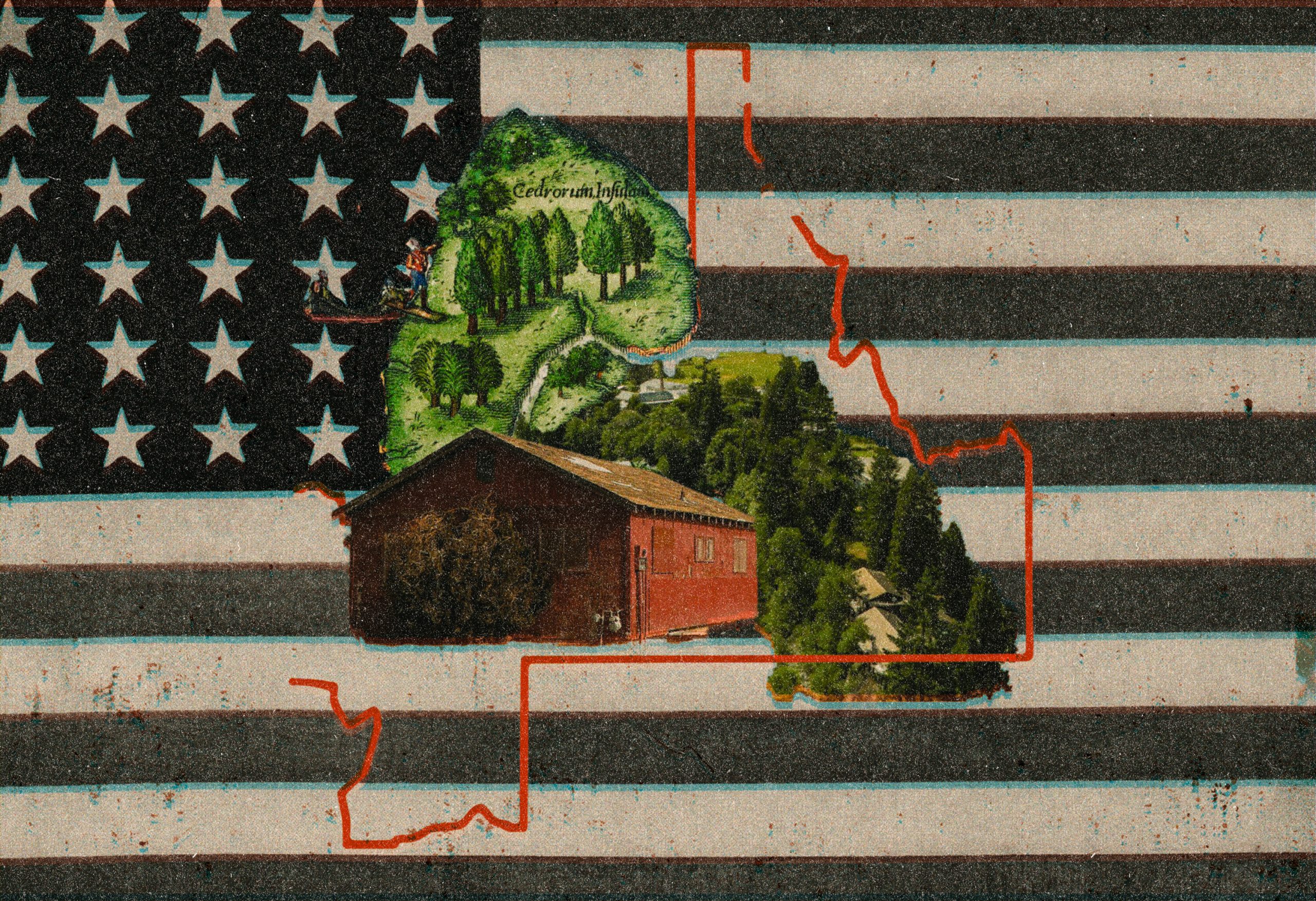A movement grows to upsize the Gem State.
The Big One

A political quake to break up California is just what residents could need.
Long before Trump flags became ubiquitous along California’s rural highways, there were signs proclaiming the State of Jefferson.
Across most of Northern and Central California, as soon as the outlying suburbs and strip malls give way to farms and oak woodland, the signs appear. Some are just sheets of plywood, makeshift billboards with “Jefferson” painted onto the weathered surface. Others are professionally designed and manufactured signs and flags, complete with the Jefferson state “seal,” a yellow gold pan with two intersecting X’s in the middle.
This movement, seeking to secede from California and form a new U.S. state, could be dismissed as a futile joke. But the signs and the flags are everywhere. They represent the sentiments of millions of Californians who know, with ample cause, that the politicians in Sacramento don’t represent them and don’t care.
Over the past ten years, beginning roughly at the same time as the Tea Party Movement became a national phenomenon, and further catalyzed by Trump’s popularity later in the decade, the State of Jefferson movement has acquired new momentum. And alienation in this increasingly polarized state is not restricted to its rural population.
Silicon Valley venture capitalist Tim Draper channeled the frustrations of millions of urbanites when he qualified the “Three Californias” initiative for the November 2018 state ballot. The initiative was struck down by the California Supreme Court, which deemed it unconstitutional, but not before it attracted international attention. Draper, who favors government decentralization and accountability, drew lines on the map that made geographic and demographic sense. And by including the populous and heavily Democratic San Francisco Bay Area in what would have become “Northern California,” and the even more populous and equally Democratic Los Angeles County in what would have become “California,” Draper clearly didn’t have partisan goals in mind.
When asked if he’s contemplated trying again, Draper said “union bosses have ruled California public education for 50 years, and during that time California’s ranking has dropped from first to 47th. It is time for a change. Breaking up the state will make each state accountable and they will have to compete for citizens. People will be able to vote with their feet.”
California’s political geography is similar to the rest of the U.S.: the cities are blue, and the rural areas are red. But California, as vividly demonstrated when visualized based on voter registration, is a deep, deeply blue state. During the Trump administration, terrified progressive urbanites launched the “Calexit” movement, dedicated to California seceding from the U.S. and forming an independent nation. Then when Biden took over as president, the movement scarcely skipped a beat. In February 2021 they announced the “Calexit Congress,” with the goal of “formally organizing and consolidating the California Independence Movement under a single flag with one unified voice.”
Breakup movements abound. According to Robert Preston the founder of New California, “the current state of California has become governed by a tyranny.” Preston’s group proposes breaking California into two states. In an initial proposal, one state would include all of the coastal urban centers, jutting inland to grab liberal Sacramento County. The other state would encompass the mostly rural remainder. Preston’s most recent proposal appears to go one step further, claiming the “the final map will reveal two states with populations that are near equal but based on rural vs urban.”
It’s easy enough to dismiss these movements, but Calexit is growing its membership. Tim Draper could revive his “three Californias” plan at any time, instantly granting the concept international scrutiny and refinement. New California has chapters in 52 of California’s 58 counties. The Jefferson movement, alive and well, has actually secured the endorsements of 22 county boards of supervisors.
There’s another reason to watch these developments carefully. California is a state of extremes. On one hand, the Golden State could easily qualify as a viable independent nation. Its diverse economy, abundant natural resources, agricultural riches, cultural power, Pacific Rim ports, and booming technology would make it one of the richest and most powerful nations in the world.
But, apart from the technology elite and pensioned seniors living in their Prop. 13-protected suburban redoubts, many Californians have been abused to the breaking point. Farmers, who, thanks to innumerable regulations from scores of agencies that often conflict with each other and change all the time, must spend more time on their desks than on their crops, are now being denied water for their crops. Politicians promise new reservoirs and aquifer storage investment so the abundant runoff from wet years can be saved for the dry years, but nothing gets built. Urban bureaucrats and litigators stop infrastructure projects in their tracks, while every year, environmentalists win new court orders and government edicts that require more water than ever to stay in the rivers and run out to sea.
California’s logging industry now harvests trees at one quarter the rate of just 30 years ago, and, tellingly, also at about one quarter the rate that California’s forests regenerate. Combine this with decades of natural fire suppression, and the conflagrations of recent years are easy to explain. Property owners in rural California can’t clear the brush around their homes without first obtaining expensive permits that hostile, indifferent bureaucrats are slow to grant, if they grant them at all. Thanks to the logjam caused by a multi-level, implacable, Byzantine bureaucracy, staffed in equal measure by fanatics and slackers, jobs that should cost a few thousand dollars and take weeks end up costing millions and take decades. So nothing gets done, and the anger grows.
Revitalizing the timber industry would thin the overgrown forests, end the superfires, and put revenue in the state treasury. Building a just a few massive off-stream reservoirs would make water scarcity a memory. But California’s urbanites are also reaching the breaking point, thanks to unaffordable housing and failing schools.
Here again, the misguided zealotry of California’s coastal elites drives failed policies, promoted by a compliant media, enforced by well-heeled environmentalist and human rights litigators, and force-fed to a brainwashed generation of youth by the leftist teachers’ unions. Housing in California doesn’t have to be expensive, but artificial scarcity has been imposed by laws that confine most new housing to within the footprint of existing cities, combined with a regime of permits and fees that add hundreds of thousands of dollars to the price of a new home.
Solutions could be readily instituted in a state freed of coastal liberal ideologues. Improve and widen the freeways. Start producing lumber and quarrying aggregates in-state to bring materials costs down. Quit repeating the preposterous lie that California is running out of “open space.” Break the power of the teachers unions over the education of 6 million students and eliminate the obsessive indoctrination of our youth into an ideology of racial division and resentment.
Californians today, more than anywhere else in the United States, are being denied opportunity by a progressive elite that has declared war on small businesses, home ownership, property management, and practical education. To date, these same elites are successfully conditioning Californians to blame their problems on each other. It is a diabolically effective distraction that prevents Californians from uniting to demand solutions.
The obvious question is whether tens of millions of disenfranchised residents will unify behind an agenda that fixes the problems, or splinter into factions and try to break up the state. One expression of unity is the recent effort to recall Governor Newsom. Over 2 million Californians, and only a slight majority of them Republicans, signed a petition demanding a recall election. The lead proponent of this recall, Orrin Heatlie, when asked about his volunteer army, had this to say:
“The recall of Gavin Newsom has brought people together and galvanized people from all walks of life. The entire political spectrum, every ethnicity, race and culture have come together to make this happen.”
The recall movement represents a powerful new force which, if motivated, could generate significant momentum towards independence from Sacramento. And they’ll have plenty of help from existing organizations and individuals that have already created the infrastructure to create shadow governments and fund ballot initiatives.
On the other hand, the recall movement is evidence of a unified opposition to an assortment of failures by California’s state government. The sources of this opposition are as diverse as the state. Can parents living in central Los Angeles that just want better schools and affordable homes empathize with rural communities? Can farmers and forest residents who just want more water and the ability to thin the forests empathize with inner-city communities? Is there a grand bargain that can unify these millions under more than just a recall, but an entire new way of governing the state?
If so, California may stay in one piece. But if not, rural Californians will not tolerate ongoing oppression by an urban majority, brainwashed to resent everything rural California represents. Nor should they.
The American Mind presents a range of perspectives. Views are writers’ own and do not necessarily represent those of The Claremont Institute.
The American Mind is a publication of the Claremont Institute, a non-profit 501(c)(3) organization, dedicated to restoring the principles of the American Founding to their rightful, preeminent authority in our national life. Interested in supporting our work? Gifts to the Claremont Institute are tax-deductible.
State and Federal officials must give local governments room to breathe.
It’s time to split the Empire State into three autonomous regions.



